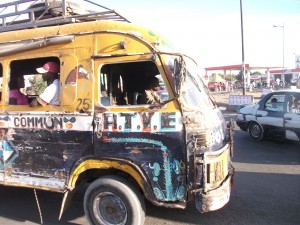by Edgard Coly
 Cars Rapides are an institution in Senegal. One can encounter this type of bus especially in the capital, Dakar, as well as other northern and central cities; but those traveling the streets of Dakar are the subject of this article.
Cars Rapides are an institution in Senegal. One can encounter this type of bus especially in the capital, Dakar, as well as other northern and central cities; but those traveling the streets of Dakar are the subject of this article.
These oversized vehicles are between an autobus and a van, carrying about 27 passengers plus the driver and the apprentice, whose role is to collect the fare from passengers and let the driver know when to stop and continue. The apprentice (who is always a young man) never sits, but hangs off the back of the bus so he can quickly jump off to assist passengers.
The Cars Rapides system works like a franchise: each vehicle is owned and operated individually, but they all follow a uniform fare. The standard look is a bright blue and yellow paint, with “Public Transportation” painted boldly on the sides and Alhamdulillah (“Thank God” in Arabic) across the front. Still, each bus has its own character and may include other small drawings or praises to one of the many local Muslim leaders.
Cars Rapides are the mode of transportation of the poor. The routes traverse downtown areas and the peripheral neighborhoods, generally avoiding posh neighborhoods where the Senegalese elite, expatriates, and foreign diplomats reside.
In Senegal, women go to visit local markets each morning to buy daily staples. With their colorful traditional outfits, these ladies seem to match the Cars Rapides. The Senegalese “drianke” (a term for a middle-aged woman, married, very sensual) never walks fast, as if she wants to give the passers-by the time to admire the shimmering colors of her dress and the scarf wrapped around her intricate braids. By the afternoon, the Cars Rapides smell like the market basket of the drianke: fresh or dry fish, pungent snail, exotic vegetables, and a hint of stale perfume.
The Cars Rapides are indeed fast, as the drivers speed, but if you are in a hurry, consider a different mode of transportation. These buses, which have always been part of Dakar’s scenery, are very dangerous. Once parked, they do not move until they get a sufficient number of passengers (as determined by the mood of the driver). The buses idle while waiting, spewing thick black fumes from the exhaust pipe that engulfs passengers and passers-by alike. Multiply the number of buses by ten and you can imagine the health implications. When entering and exiting, riders must pay particular attention to the extremities of the seats as well as their padding. The scrap metal frames, dog-eared by time, heavy use, and poor maintenance leave protruding, sharp pieces of metal that prick or graze the inattentive passenger; the risks of tetanus are obvious.
Competition for clients is fierce because of the large number of Cars Rapides and cheap fare. This means that spotting a fare along the route is crucial. The driver slams on the brakes at any indication from the apprentice that a pedestrian may need a ride. These sudden stops occur in traffic, causing frequent accidents. The wild speed of the Cars Rapides is another worry for pedestrians, especially given the lack of traffic lights (which no longer exist in this busy, crowded city). City dwellers know the Cars Rapides will never yield to them, even in crossing areas.
The passenger who reaches his destination must ensure the vehicle is completely stopped, then make a rapid exit. In his hurry to catch a potential client further down the road, the apprentice tends to give the departure signal before the exiting passenger has completely disembarked, often resulting in spectacular falls and even serious injuries.
Why not reform the Cars Rapides system? Rumor has it that these vehicles belong to powerful political individuals, thus explaining the lack of will to regulate it. Since the victims of these walking coffins are invisible, the politicians do not need to act because they do not know.
Edgard Coly currently teaches French at the Monterey Institute. He completed his Doctorate at the University of Colorado-Boulder, where he also taught. He gave lectures for the Center for Teaching International Relations (CTIR) at the University of Denver. Prior to his postgraduate work, Professor Coly taught French to foreign service officers. He also trained Peace Corps volunteers in French, Wolof, and Jola. His professional experience includes teaching French and African History to Youth at Risk at Washington Ethical High School. His work has appeared in a Senegalese newspaper Le Cafard Libéré and in Contes et Mythes du Sénégal, a compilation of short stories. He is an active member of American Association of Teachers of French, African Literatures Association, NAACP Monterey Peninsula Branch, and the Modern Language Association.
 Advocating for nonviolent change, the Center for Conflict Studies emphasizes research and practice to better understand conflicts and manage them effectively in order to bring changes to current inequalities and social injustices. Our magazine, Reflections, will be published in annually.
Advocating for nonviolent change, the Center for Conflict Studies emphasizes research and practice to better understand conflicts and manage them effectively in order to bring changes to current inequalities and social injustices. Our magazine, Reflections, will be published in annually.

